Evolution of Branding: Lessons Learned From Successful Rebrands
Think about one brand you know well. Likely, you know their name, logo, and colour scheme. These components contribute to a brand's identity, and proper branding can be a powerful marketing tool. Excellent and consistent branding has many benefits, including brand recognition, consumer loyalty, search engine visibility, and increased sales, all of which will help your business thrive.
Despite these benefits, there are cases when businesses and organisations go through rebranding, and there are several reasons why they choose to change their signature style. Regardless of their reasoning, successful rebrands can refresh a stale look and bring new life into a business. This article will examine several unsuccessful and successful rebrands and help you learn from their experiences.
Table of Contents
What Is a Rebrand, and What Is Its Purpose?
First, what is a rebrand? A rebrand is when a business or organisation changes its branding to something new. In some cases, this might be a total overhaul where they change their name, colours, logo, mission, and more. Other times, changes are only made to one of these things. Both approaches have their pros, cons, and reasons behind the adjustments.
But what is the purpose of a rebrand? Each business or organisation will have a unique reason behind its rebranding. Regardless of the particular reasons, it typically comes from wanting to change how a company is perceived. This could be because of a change in leadership, the need to hone their products and services, their mission altered, or a combination of these things.
Successful Rebrands
Now that you understand a rebrand and why some brands go through the process, we will use some examples. This section will dive into five successful rebrands and overview the lessons learned from each.
Example 1 – Jet Dry and Electasol Became Finish
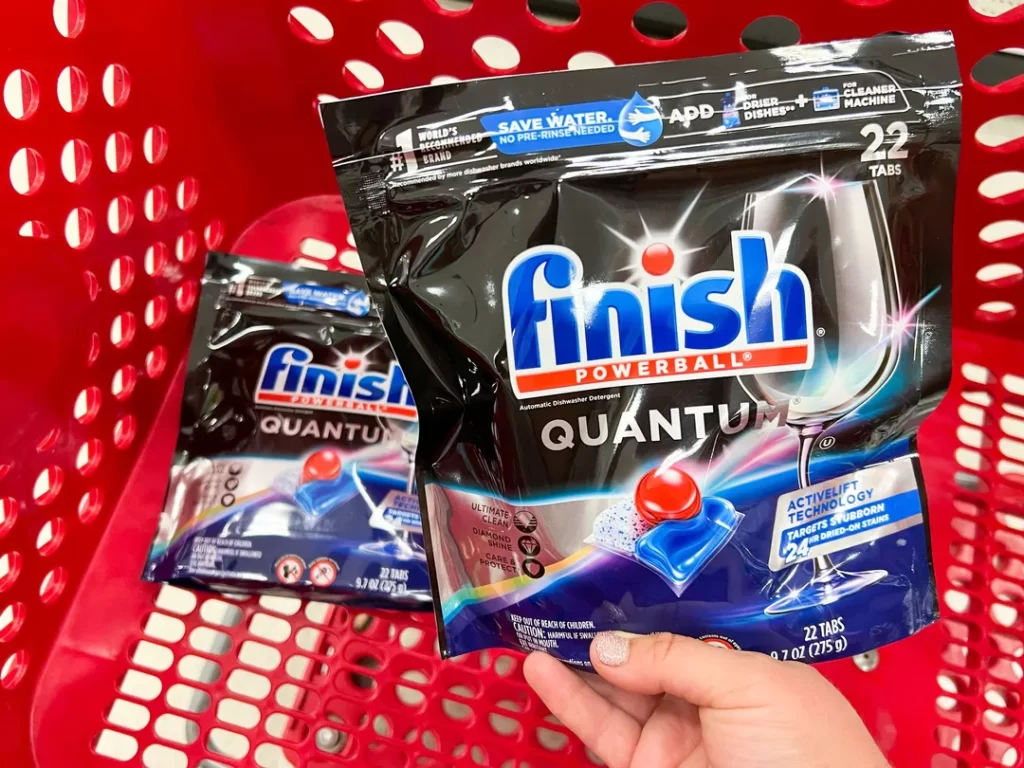
The dishwasher detergent, now Finish, was known as Jet Dry in the United States. According to a 2009 New York Times Q&A with Stuart Elliott and James Watson, the name change was initiated to optimise production, marketing, and brand recognition.
Originally, Electrasol, Jet Dry, and Finish were all separate names for the same product, and the three major countries they sold in were the U.S., France, and Germany. The company saw it could create global recognition with Finish since it was already successful and advertise its new product with its rebranded name.
When the shift began, their packaging and commercials featured both names, but Finish was put in large print, and Jet Dry/Electrasol was put underneath in small letters. Eventually, advertisements and products only carried the Finish name.
Lesson Learned
The main takeaway from this rebrand is how well the company understood its consumers in individual countries and how it stood up as a global company. Finish already had more recognition globally than Electrasol and Jet Dry, so it made sense to consolidate the names. This consolidation streamlined branding and marketing since packing no longer needed a different name based on where the product was sold.
Moreover, the company's products had no major controversy or change. Its advertising efforts made it clear that consumers were getting the exact product they already knew and trusted. As you can see, their rebrand was more of a shift than a significant change.
Example 2 – Lego

Lego was founded in 1932, and for a long time, it reigned supreme, easily kept up with competitors, and expanded beyond toys into other industries like theme parks (i.e., Legoland). However, in the 1990s, this began to shift.
According to Paul Merrill, from TheCEOMagazine.com, in 2003, Lego was estimated to be in $800 million (USD) of debt, but soon Jørgen Vig Knudstorp came on as CEO. He set out to find and solve the company's problems and downsized to reduce operation costs. Knudstorp quickly saw the company's roots and its target audience – children.
Luckily, these changes paid off, and the brand is still around today. Lego's story is such a success that David Robertson and Bill Breen wrote a book, Brick by Brick: How Lego Rewrote the Rule of Innovation and Conquered The Global Toy Industry, which tells Lego's story in detail.
Lesson Learned
Change is an inevitable part of life, and mistakes are bound to occur. Lego is no exception, as it has had its fair share of changes and errors over ninety years of business.
Although there were initial successes with the company's expansion into other domains, it eventually spread the business too thin and no longer catered to its core group of consumers. Trying to sell a product to someone who is not interested in a complex sale to make. Eventually, this became a significant issue, and the company needed to redirect its strategy to survive.
Instead of a complete change in direction, Knudstorp went to its target audience for guidance and found success by returning to its roots. There were other factors at play, but the main lesson from this story is knowing your target audience and catering to their wants and needs.
Example 3 – Old Spice
Old Spice is another brand that has been around for decades, and it rebranded in 2010 when its marketing campaigns focused on a new target audience. Before 2010, the company's advertisements focused on men's user demographic, leaving women, another buyer group, out of the picture.
Old Spice's brand refresh expanded its target audience to include women. The company's marketing campaign of The Man Your Man Could Smell Like was wildly successful because it focused on the right audience, called them to action, and did it light-heartedly. This comedic twist made the ad memorable.
Lesson Learned
Sometimes, it is helpful to expand your target audience; however, you also do not want to over-generalise. In the case of Old Spice, the company was not looking to appeal to everyone but rather a younger audience that included women.
They accomplished this by calling women to action through their line, “but if he stopped using lady-scented body wash and switched to Old Spice, he could smell like he's me.” Additionally, the ad was humorous and quirky through its unpredictable chain of events which easily kept the viewer's attention.
Example 4 – Starbucks
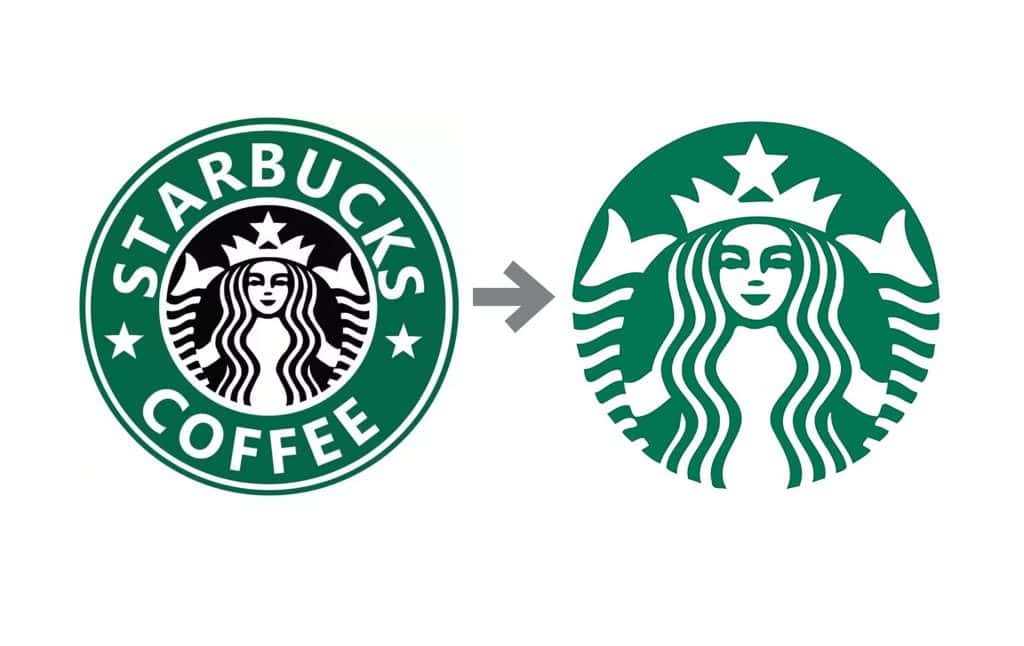
Starbucks initially launched with a logo that featured a siren and the words “Starbucks, coffee, and tea.” The logo has seen its fair share of updates over the years, and in 2011, the company dropped all words and simplified the siren's look.
Per Starbucks' website, the brand felt its reach had grown enough globally that people could recognise its iconic figure without its name. Their assumption that their logo was still easily identifiable was correct, and the brand continues to see success with its new logo.
They were no longer bound to coffee and tea as their main products. Now they can focus on various beverages, even if coffee remains at the heart of their operations.
Lesson Learned
When Starbucks altered its logo, it kept its character familiar and its colours unchanged. Consumers could see the differences but knew who they were purchasing from and the standards they had come to expect from the coffee brand.
One lesson that can be taken from Starbucks is they understood what was iconic about its logo – its colour and character. This concept can be applied to various aspects of your brand. If you want to update your look, you must ensure consumers can distinguish your brand from its competitors.
Example 5 – Target

Instead of a change in its logo or motto, Target took its brand in a new direction through partnerships. Specifically, they looked into luxury fashion made for Target shoppers.
The trend debuted in 2011 with the Italian fashion brand Missoni and has continued with other brands and designers like Jason Wu, Lilly Pulitzer, Marimekko, and Hunter. The company's initial campaign with Missoni saw massive success, with most of its pieces selling out. Many of Target's follow-up campaigns have seen similar results.
Lesson Learned
Rebranding sometimes focuses on the products and services rather than a company's look. Target set itself apart from competitors like Walmart and Kmart by partnering with high-end brands and offering these items at a more reasonable price.
Instead of making a random change to their brand, Target created a reason for consumers to return to their store that fit their brand identity. They have continued to see success with this strategy as each new designer or brand brings novelty to their apparel offerings.
The lesson that can be garnered from this rebrand is to think outside the box but within your brand's identity. Sometimes, a little novelty can refresh a consumer's interest in a brand and peak the interest of new shoppers. Additionally, partnerships bring the attention of one fan base to another company's work; thus, a wider audience is reached without the need for extra marketing.
Unsuccessful Rebrands
Not all brands will obtain the revamp they seek when rebranding. Thankfully, there are still lessons to be learned from these situations. This section will look at rebrands that did not go as planned and key takeaways from their cases.
Example 1 – British Petroleum, aka BP
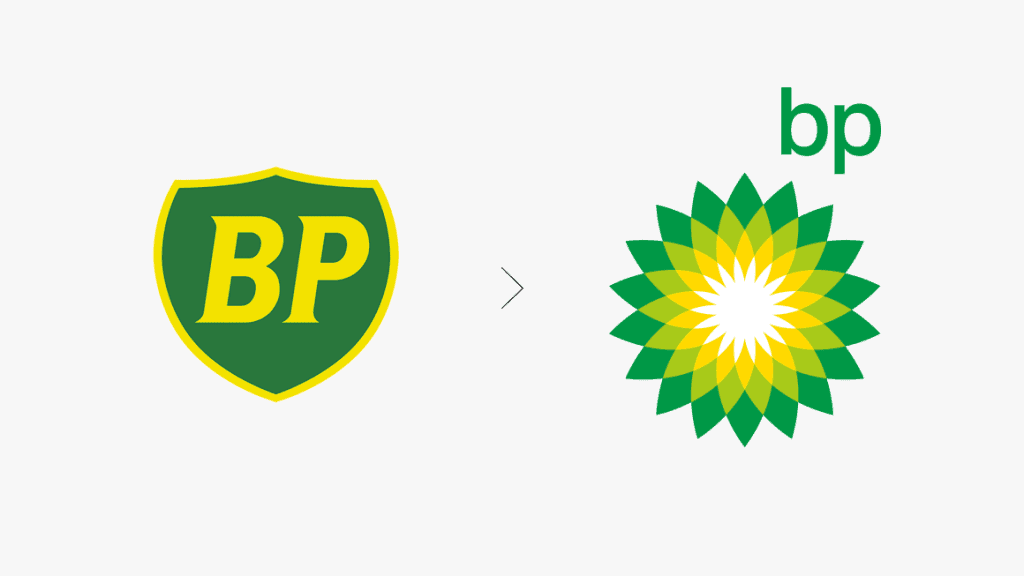
Over twenty years ago, BP released its new logo and marketing campaign centred on greener and cleaner energy. However, this move made many suspicious, leading to consumer backlash. Public scrutiny increased when there was an explosion on the Deep Water Horizon Oil Rig owned and operated by BP. Unfortunately, this led to the largest recorded oil spill.
BP did manage to pull through the public scrutiny, as the company is still around today; however, over a decade later, it is still dealing with the ramifications of the accident. For instance, now several workers from the oil clean-up are reporting poor health conditions that may be related to the oil exposure.
Key Takeaway
Natural gas and oil products are well-known pollutants. According to the United States Environmental Protection Agency, prolonged exposure to these compounds and their by-products can lead to health concerns like asthma and cancer.
It is common knowledge that these products can be dangerous for the environment and its inhabitants, so a branding campaign focused on clean energy comes off as disingenuous.
The big lesson here is to stay true to your mission and values and not try to promote your brand as something it is not. It isn't very trustworthy and makes your business less reliable.
Example 2 – Tropicana
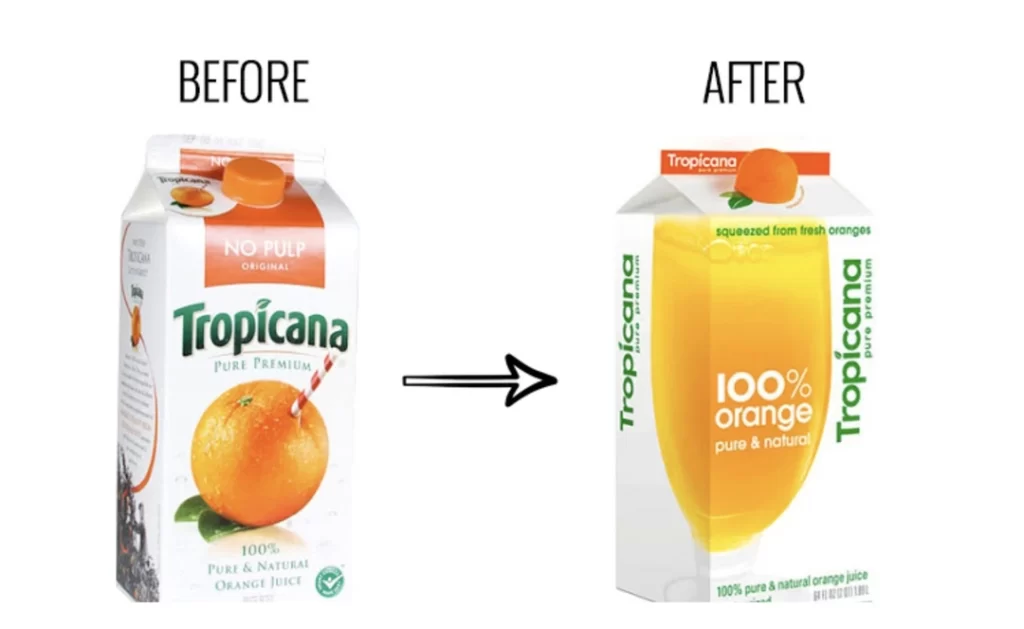
Like Starbucks, Tropicana consumers knew their orange juice was the correct carton when they saw an orange with a straw stuck in it. In 2009, the company chose to update several aspects of its packaging. There was no longer the well-known image of an orange, their phrasing was altered, and their text was rotated to vertical rather than horizontal.
All of this led to consumer confusion, and Tropicana saw a twenty per cent decrease in sales two months after their changes were implemented. The website also reported that the company lost around 50 million dollars and soon returned to its original packaging.
Key Takeaway
Understandably, brands want to refresh their look and keep things modern. Regrettably, Tropicana made the mistake of making too many changes at once. Their brand was already well known and trusted, so their updates came across as confusing to their loyal consumers.
The takeaway from this rebranding failure is ensuring your brand is still recognisable. Alterations can be made; however, consider keeping them small and distributing changes over time rather than all at once.
Example 3 – Pepsi Blue

Pepsi is a well-known soda company that has worked hard to refresh things every once and a while. In the early 2000s, the brand launched Pepsi Blue, a blue beverage with berry flavouring.
At first, they saw success with their new soda, but after a year, sales dwindled. Ultimately, Pepsi chose to discontinue the product. Many factors were at play, but some speculate the product's downfall came from a lack of novelty and reports of potentially harmful dyes used to colour the product.
Key Takeaway
Initial success only sometimes leads to lasting results. Sometimes, it is curiosity that leads to sales rather than a good product.
Some brands use this to their advantage by only offering products during certain times of the year. For instance, consumers expect pumpkins and warm spices like cinnamon during the fall season. As a result, companies will offer pumpkin spice products during the fall but not year-round.
Remember, a product needs to be desirable for this strategy to work. In other words, limited edition items can be used to test whether a product or product type will be a viable investment for a business.
Tips for Successful Rebrands
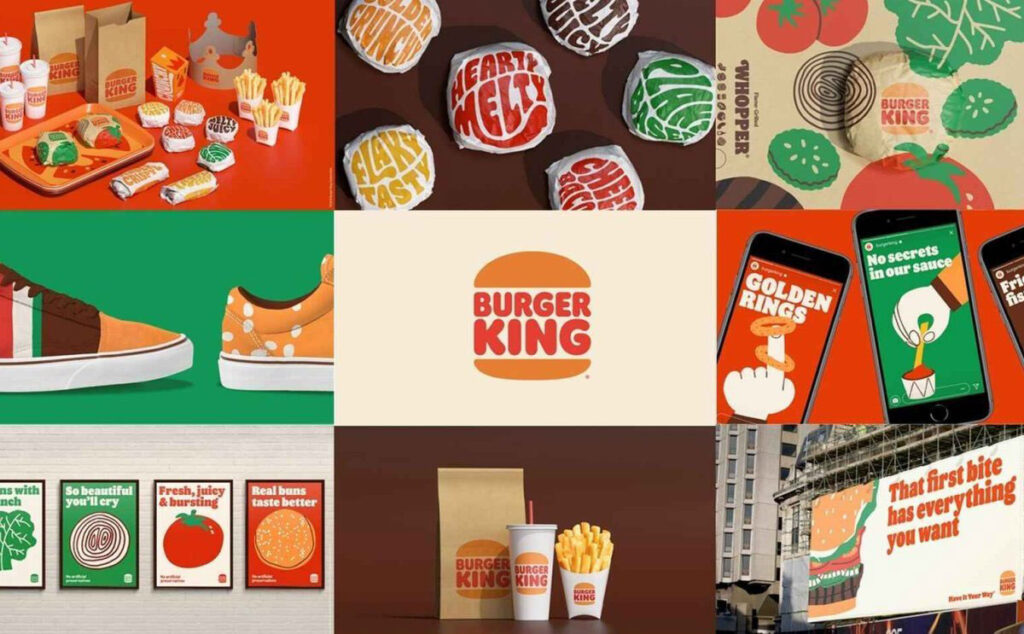
Keep Your Customers at the Forefront
Trust and loyalty take time to cultivate, so you must remain trustworthy to your clients. Partnerships with brands that have opposing values, drop in product and service quality, and unfavourable practices like poor working conditions are all ways that will make your reputation plummet.
Instead, it would help if you focused on patrons' emotional connection with your brand. Think about what makes people want to buy from you. For instance, Lego's brand is built on fun and reliable toys, and the company seeks out its consumers when it develops new products to ensure the buyer's needs are met.
Furthermore, customer service is as essential as the quality of your products. According to one report, 91% of customers say that a positive customer service experience makes them more likely to repurchase from that business.
Many companies are now turning to customer relationship management (CRM) software like Zendesk, which supports operations to improve customer service. However, there are also alternatives to Zendesk that better suit your needs for CRM software, as there are cheaper options, more accessible to learn, and more geared to SaaS businesses (if this applies to you).
Create a Strategy
It is obvious to employees and patrons when a rebrand occurs without a plan or a clear goal in mind. It would be best to devise a clear strategy for your alterations to avoid this situation.
First, take a look at your current mission and values. Now, ask yourself, do these still align with how your brand/business operates? If you still need to, you must decide the differences and how you would like to address them.
Remember, saying and doing are two different things, so it can be helpful to set goals, define why you want to make these changes and write out how you will make your changes.
Make Changes Incrementally
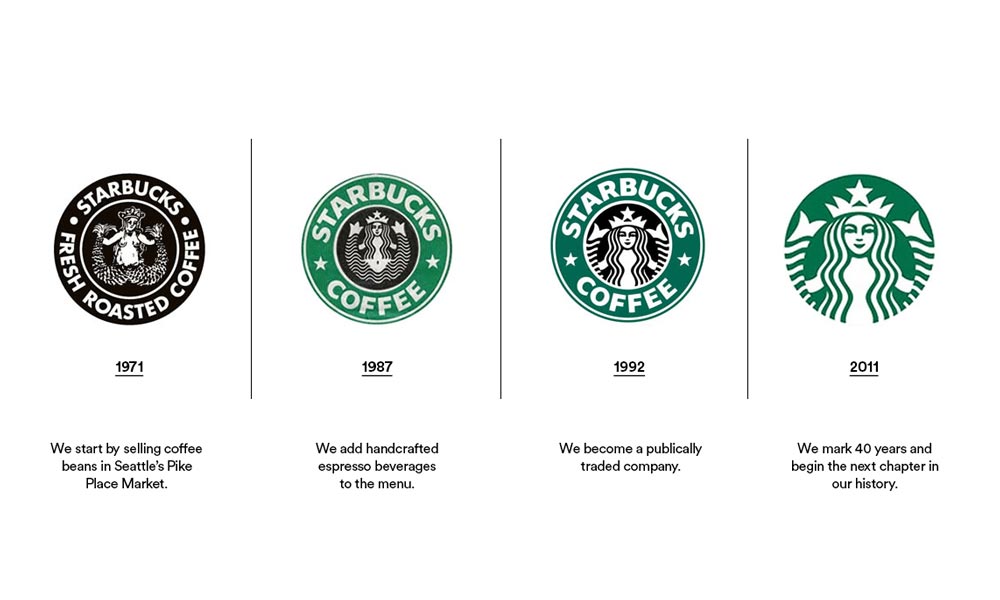
Drastic changes tend to shock consumers; too much difference can leave your brand unrecognisable. This caused Tropicana's rebranding mistake – consumers could no longer quickly pick out their trusted brand on grocery store shelves.
On the other hand, Finish saw success with their rebrands since they released commercials and products with their original and new names until buyers became familiar with the change. What's more, they kept their colour scheme relatively similar as well.
eBay also saw success with this approach after a drastic change from a yellow to a white background led to several complaints. They still wanted to update their website but chose to alter the background colour slowly over several months until they reached their desired colour.
There are some exceptions to this tip. For example, Finish was able to succeed with its name change for a few reasons. For starters, they only made one change, their name, and they made it clear to consumers that their name was the only alteration being made to their products. Moreover, the company kept its original name on its packaging and marketing materials until the new name became the norm for its returning customers.
Use A/B Testing
As we have examined throughout this article, change is only sometimes welcomed, and it can be difficult for consumers to cope. This is where A/B testing comes in.
A/B testing is a technique that is used to organise consumers into groups and show them different marketing campaigns, website changes, and more to determine a general sense of how it will be received. After you've gathered some feedback, you can make alterations so that the version you use for an official launch is more likely to succeed.
Keep Your Website Mobile Friendly
Mobile browsing and shopping continue to increase, so it is vital to remember that during your rebrand. Websites should be updated to be mobile-friendly, and logos must remain recognisable even when shrunk.
Your mobile site should also have responsive pages that easily and quickly fit horizontal or vertical views, fast loading times, simplified navigation, minimal need to zoom in or out, and touchpoints that are easy to tap.
Final Thoughts
Brands and businesses change over time, and a rebrand can help keep a business' identity aligned with its mission and operations. Of course, there are many ways to approach a rebrand, and they can be successfully executed if you can learn from others' successes and failures.
What's more, InkBotDesign.com has the tools, resources, and experts to help you navigate your brand's journey – whether it is updating your look, streamlining your branding, or something else.
